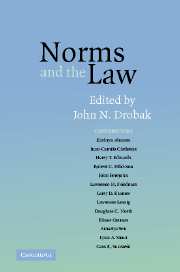Book contents
- Frontmatter
- Contents
- List of Contributors
- Acknowledgments
- Introduction
- PART ONE RATIONALITY AND NORMS
- PART TWO NORMS OF THE COMMONS
- PART THREE JUDICIAL NORMS
- 7 Judging the Judges: Some Remarks on the Way Judges Think and the Way Judges Act
- 8 Judicial Independence in a Democracy: Institutionalizing Judicial Restraint
- 9 Black Judges and Ascriptive Group Identification
- 10 Judicial Norms: A Judge's Perspective
- PART FOUR THE INFLUENCE OF LAW ON NORMS
- References
- Index
8 - Judicial Independence in a Democracy: Institutionalizing Judicial Restraint
Published online by Cambridge University Press: 05 June 2012
- Frontmatter
- Contents
- List of Contributors
- Acknowledgments
- Introduction
- PART ONE RATIONALITY AND NORMS
- PART TWO NORMS OF THE COMMONS
- PART THREE JUDICIAL NORMS
- 7 Judging the Judges: Some Remarks on the Way Judges Think and the Way Judges Act
- 8 Judicial Independence in a Democracy: Institutionalizing Judicial Restraint
- 9 Black Judges and Ascriptive Group Identification
- 10 Judicial Norms: A Judge's Perspective
- PART FOUR THE INFLUENCE OF LAW ON NORMS
- References
- Index
Summary
The Constitution establishes the judiciary as a co-equal department of the federal government and protects its members from political interference by granting them life tenure and prohibiting Congress from reducing their salaries. Yet Congress is free to decide whether to create lower federal courts at all, to define their jurisdiction narrowly or widely, to establish rules of procedure, and to determine the size of the judiciary's budget. Moreover, federal courts are not only staffed by presidential nominees, they must also rely on the executive branch to enforce their judgments. From this perspective it is hard not to agree with Alexander Hamilton who noted in Federalist 78 that the judiciary, having neither purse nor sword, is the “least dangerous branch.” Hamilton, it must be said, offered this as assurance to those who feared the new constitution might establish independent and unaccountable judges as threats to liberty. But he surely worried that the complex ways in which federal judges were embedded in the political structure and their dependence on the political branches might undermine their capacity to withstand political pressures.
A contemporary observer might be forgiven for thinking, after two centuries of practice, that these concerns about the independence of the federal courts were overblown. Starting with its clever and cautious stance in Marbury v. Madison, the Supreme Court has proved more than capable of protecting its institutional powers relative to the other branches and, even more, relative to the state governments.
- Type
- Chapter
- Information
- Norms and the Law , pp. 161 - 207Publisher: Cambridge University PressPrint publication year: 2006
- 12
- Cited by

